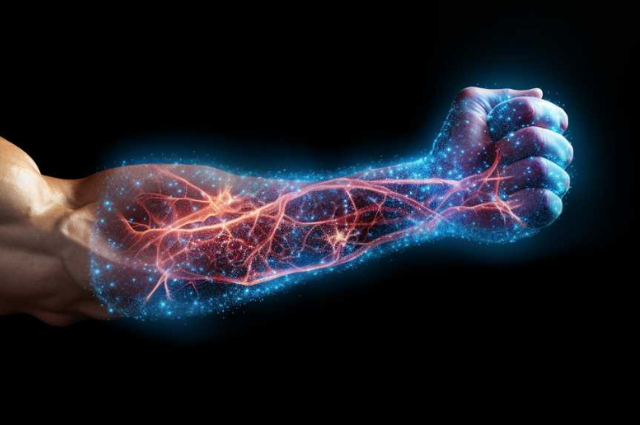Why Do Anabolic Steroids Cause Side Effects?
\Anabolic steroids, while often used to enhance physical performance, can cause significant side effects due to their potent impact on the human body. These synthetic substances mimic testosterone, disrupting the body's natural hormonal balance and triggering a range of physiological responses.
The side effects of anabolic steroids result from these alterations in the body's biochemistry. This report will delve into the detailed mechanisms of action of anabolic steroids, explore their common and long-term side effects, their psychological impacts, and discuss safer alternatives available.
Understanding these aspects is crucial for athletes and others who might consider using these substances for performance enhancement.
Key Takeaways
- Anabolic steroids disrupt the body's natural hormone balance, leading to hormonal imbalances and changes in hormone production.
- Steroids interact with androgen receptors in various tissues, causing side effects such as increased body and facial hair in women and testicular shrinkage in men.
- The liver metabolizes steroids, producing toxic metabolites that can damage the liver.
- Prolonged use of steroids can lead to physical and psychological dependency, as well as negative effects on mental health such as mood disorders and aggression.
Understanding Anabolic Steroids
A significant number of athletes and bodybuilders use anabolic steroids to enhance their performances, yet many lack a comprehensive understanding of these potent substances and their potential side effects. Anabolic steroids, or anabolic-androgenic steroids (AAS), are synthetic variations of testosterone, the primary male sex hormone. They are prescribed by healthcare professionals to treat conditions such as delayed puberty and muscle loss caused by diseases like cancer and AIDS. However, these substances are often misused by athletes and bodybuilders to increase muscle mass and improve performance.
The reason why anabolic steroids can cause side effects is primarily due to their mechanism of action. Anabolic steroids work by binding to the androgen receptor within muscle cells, stimulating cell growth. However, they also affect other types of cells and organs in the body, leading to a plethora of potential side effects.
For instance, anabolic steroids can cause an increase in red blood cell production, which can increase the risk of blood clots. They can also lead to liver damage, high blood pressure, and changes in cholesterol levels, increasing the risk of heart disease. Furthermore, since anabolic steroids are synthetic versions of testosterone, they can disrupt the body's natural hormone balance, leading to side effects such as decreased sperm production, testicular shrinkage, and breast enlargement in men, and deepening of the voice, menstrual irregularities, and increased body hair in women.
Thus, while anabolic steroids can provide short-term benefits in terms of enhanced athletic performance and increased muscle mass, their misuse can lead to serious health consequences.
Anabolic Steroids and the Human Body
Understanding the impact of anabolic steroids on the human body necessitates a deep dive into the physiological changes induced by these powerful substances. Anabolic steroids are synthetic variations of the male sex hormone testosterone. They are designed to enhance muscle growth, improve athletic performance, and promote physical attractiveness. However, the human body is a complex system, and manipulating it with anabolic steroids can result in a wide array of undesirable side effects.
The human endocrine system, which regulates hormone production, is particularly sensitive to the introduction of anabolic steroids. These substances can disrupt the balance of hormones, leading to changes such as increased body and facial hair, deepening of the voice, and an enlarged clitoris in women. Men may experience testicular shrinkage, reduced sperm count, and the development of breast tissue.
Furthermore, anabolic steroids can have a profound impact on the cardiovascular system. They can elevate blood pressure, increase bad cholesterol levels, and decrease good cholesterol levels, all of which can contribute to heart disease. There is also evidence that steroids can increase the risk of blood clots, leading to potentially life-threatening conditions like stroke or heart attack.
Steroids can also wreak havoc on the psychological wellbeing of users. Mood swings, irritability, aggression, and even severe psychiatric disorders can be side effects of steroid use. These mental health issues can persist long after the drug use has stopped.
The Chemistry Behind Steroids
How exactly do anabolic steroids interact with our body's chemistry to cause such widespread and significant side effects? To understand this, we must delve into the complex world of biochemistry.
Anabolic steroids are synthetic variations of the male hormone testosterone, designed to promote muscle and bone growth. Despite their molecular similarities, anabolic steroids and natural testosterone are not identical. The alterations made to the steroid molecule enhance its anabolic properties but also lead to its androgenic effects, which are responsible for many of the side effects.
When anabolic steroids enter the bloodstream, they bind to specific receptors on the cell membranes, called androgen receptors. This binding triggers a cascade of biochemical reactions within the cell, leading to the transcription of specific genes that promote muscle growth. However, androgen receptors are not exclusive to muscle cells. They are also found in other tissues like the skin, hair follicles, and the liver. This widespread distribution is why anabolic steroids can cause a diverse range of side effects.
The liver, in particular, bears the brunt of steroid metabolism. It attempts to break down and excrete these foreign substances, producing metabolites in the process. Some of these metabolites are toxic and can cause liver damage. In addition, the altered hormone balance caused by steroid use can disrupt the body's natural hormone regulation, leading to additional side effects such as mood swings and acne.
Common Side Effects of Steroids
Often, individuals who use anabolic steroids experience a host of common side effects, stemming from the widespread interaction of these substances with various bodily systems, as detailed in the previous section. Notably, these side effects can be physical, psychological, or a combination of both, varying significantly in severity and duration.
Physically, steroids can induce significant hormonal imbalance, leading to a multitude of side effects. For men, this imbalance can cause gynecomastia, testicular atrophy, and decreased sperm production. Women may experience masculinization, characterized by deepening of the voice, increased body hair, and irregular menstrual cycles. Both genders might experience acne, hair loss, liver damage, cardiovascular problems, and increased risk of infections due to the use of non-sterile injection techniques or sharing of needles.
Psychologically, steroids can induce mood disorders, including increased aggression, known as 'roid rage', along with depression, mania, and psychosis. The severity of these effects can range from mild mood swings to serious mental health issues requiring professional intervention.
Moreover, prolonged use of steroids can lead to physical and psychological dependency. As such, sudden cessation can result in withdrawal symptoms, including fatigue, restlessness, loss of appetite, insomnia, and decreased libido.
Long-Term Impacts of Steroid Use
Continually, the long-term use of anabolic steroids extends beyond the immediate side effects, leading to persistent and potentially irreversible health conditions. The range of consequences is broad, impacting various systems of the body and manifesting in diverse ways.
One of the most severe impacts of prolonged steroid use is cardiovascular disease. Anabolic steroids can cause an increase in LDL (bad) cholesterol and a decrease in HDL (good) cholesterol, leading to the buildup of plaque in the arteries, atherosclerosis, and potentially heart attacks or strokes. Increased blood pressure is another potential heart-related side effect, posing additional risk of heart disease.
Furthermore, anabolic steroids can have deleterious effects on the liver, leading to conditions such as peliosis hepatis, a disease characterized by blood-filled cysts in the liver. Steroid-induced liver damage can also lead to liver cancer. In addition, chronic users may experience hormonal imbalances, leading to infertility, reduced sperm count in men, and menstrual irregularities in women.
The skeletal system can also be affected, with steroids causing premature closure of growth plates in adolescents, leading to stunted growth. In adults, long-term use can result in osteoporosis.
Psychological impacts of long-term steroid use should not be overlooked. These can include mood swings, aggression, and depression. Furthermore, continued use can lead to dependency, with withdrawal symptoms including mood disorders and fatigue.
The Psychological Effects of Steroids
In addition to the physical health risks, the use of anabolic steroids can also precipitate a host of psychological side effects. These psychological effects range from mood swings and increased aggressiveness to more severe outcomes such as addiction and mental disorders.
Steroids are known to impact the brain's limbic system, which is responsible for mood, memory, and behavior. Therefore, when steroids are used, an individual may experience drastic mood swings, irritability, and increased aggression, commonly known as 'roid rage.' This heightened aggression can also lead to violent behavior. According to a study published in the Journal of Clinical Psychiatry, 22% of steroid users reported increased aggression.
Moreover, steroids can lead to psychological dependence, causing users to continue taking them despite experiencing negative effects. This addiction can result in withdrawal symptoms like depression and apathy when the user ceases steroid use.
Another concerning psychological impact is the possibility of developing mental disorders. A 2015 study in the American Journal of Psychiatry found that long-term steroid use could increase the risk of developing bipolar disorder and depressive disorders.
In severe cases, steroid use can lead to paranoia, delusions, and even suicidal ideation. A review in the Journal of Sports Science & Medicine revealed that individuals who abuse steroids are more likely to have suicidal thoughts and attempts.
Steroids and Athletic Performance
Beyond the psychological effects, anabolic steroids are also frequently used in athletics due to their performance-enhancing properties. Steroids achieve this improvement through various physiological changes they cause in the body, primarily through the increase in muscle mass and strength. This is achieved by the promotion of protein synthesis, which leads to muscle growth, and the reduction in muscle damage through the inhibition of cortisol, a hormone that breaks down muscle tissue.
However, the use of anabolic steroids in sports is not without controversy. The World Anti-Doping Agency and numerous sports federations have banned their use due to the unfair advantage they provide and the potential health risks they pose. Despite this, their use remains widespread, as detection methods struggle to keep up with the evolving nature of these substances and their administration methods.
Long-term use of anabolic steroids can lead to a range of health complications. These include cardiovascular issues such as hypertension and heart disease, liver damage, and hormonal imbalances, which can lead to secondary sexual characteristic changes, infertility, and mood disorders. The pursuit of improved performance, unfortunately, often overshadows these risks.
Alternatives to Anabolic Steroids
Given the serious health complications associated with anabolic steroids, it is pertinent to explore safe and legal alternatives for enhancing athletic performance. These alternatives can be broadly classified into two categories: natural supplements and lifestyle modifications.
Natural supplements, often marketed as 'legal steroids', are substances designed to mimic the muscle-building effects of anabolic steroids without the associated side effects. Examples include creatine, protein powders, branched-chain amino acids (BCAAs), and beta-alanine. These substances work by enhancing the body's natural ability to synthesize proteins, thus facilitating muscle growth and repair. For instance, creatine is shown to increase strength and lean body mass when combined with resistance training. However, it's crucial to note that while these supplements can augment training outcomes, they do not offer the same dramatic results as anabolic steroids.
Lifestyle modifications include changes in diet, exercise routines, and sleep patterns. A well-balanced diet rich in protein can aid muscle recovery and growth. High-intensity interval training (HIIT) can improve strength and endurance, while adequate rest and sleep are essential for muscle repair and growth. Regular monitoring of these factors can help athletes achieve their performance goals without resorting to harmful substances.
Frequently Asked Questions
What Is the Legal Status of Anabolic Steroids in Different Countries?
The legal status of anabolic steroids varies globally. In the United States, they are classified as Schedule III controlled substances, meaning their non-medical use is illegal.
In Canada, it is legal to possess steroids, but illegal to traffic.
The UK allows possession for personal use but outlaws supply or production.
Australia has strict laws, prohibiting possession without a prescription.
It's crucial to note that these legal stances are subject to change and variation.
What Is the History and Origin of Anabolic Steroids?
Anabolic steroids, also known as anabolic-androgenic steroids (AAS), originated in the 1930s as a synthetic derivative of testosterone. Scientists developed these substances to treat medical conditions like muscle wastage.
The advent of World War II saw increased use of anabolic steroids to boost soldiers' strength and endurance. However, the 1950s and 1960s witnessed their misuse in sports, leading to their controversial status today.
Are There Any Notable Cases of High-Profile Athletes Being Caught for Steroid Use?
Yes, there have been numerous high-profile cases of athletes caught using steroids.
Some of the most noteworthy include cyclist Lance Armstrong, who was stripped of his seven Tour de France titles due to doping, and baseball player Alex Rodriguez, who was suspended for the entire 2014 season.
These cases highlight the serious repercussions of steroid use in professional sports, not only for the athletes' health but also for their careers and reputations.
How Are Anabolic Steroids Typically Administered or Taken?
Anabolic steroids are typically administered through two methods: oral ingestion or injection.
Oral steroids are consumed in pill form and are convenient, but can cause liver damage due to their direct pathway to the liver.
Injectable steroids, on the other hand, are directly introduced into the muscle, bypassing the liver and reducing the risk of liver toxicity.
However, injections carry their own risks, such as infection at the injection site.
How Does the Cost of Anabolic Steroids Compare to Other Performance-Enhancing Substances?
The cost of anabolic steroids varies widely, depending on the type, dosage, and source. While some may be relatively affordable, others can be quite expensive. When compared to other performance-enhancing substances, anabolic steroids are generally on the higher end of the price spectrum.
This is due to their potent effects and the complex manufacturing process involved. The cost can also increase if acquired illegally or without a prescription.
Conclusion
In conclusion, anabolic steroids exert a multitude of side effects due to their synthetic nature and interaction with various body systems. These effects range from short-term physical changes to long-term health implications and psychological disturbances.
While they may enhance athletic performance temporarily, the detrimental impacts underline the need for safer alternatives. Therefore, a comprehensive understanding of their mechanisms, impacts, and the potential alternatives is crucial for informed decision-making regarding their use.







